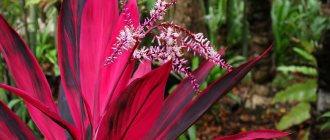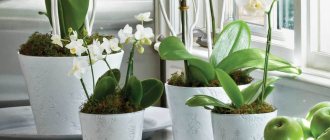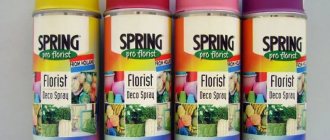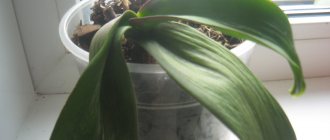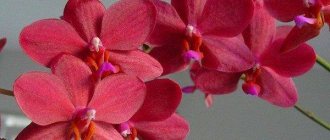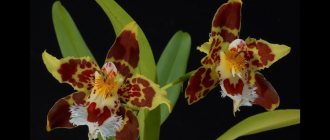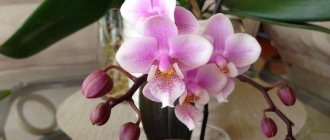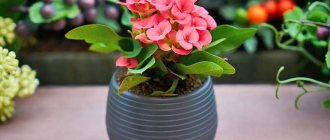The concept of Phalaenopsis (lat. Phalaenopsis) combines popular varieties of orchids that are adapted for growing at home. These delicate flowers of amazing beauty look like a butterfly.
Phalaenopsis is a slowly growing orchid that belongs to the genus of epiphytic herbaceous plants. The original color of the Phalaenopsis orchid growing in nature is white. As a result of breeding work, scientists have obtained many varieties and varieties of this plant; they differ in a wide variety of shades.
What colors are there: names and real photos
Breeders have given the world varieties of the most unimaginable colors; specimens with striped and spotted petals have appeared. Phalaenopsis belongs to the following categories based on color:
- Single color. Basically, varietal plants have the same tone. Pink, white, yellow and purple phalaenopsis are common.
- Multicolor. These include varieties with two-color petals with spots or stripes.
What are the most common phalaenopsis plants? Let's talk about popular and exotic shades and the brightest varieties of this color.
Transfer
Priming
The basic requirements for soil or, as it is also called, substrate, are as follows:
- as a support for a plant;
- have good water and breathability;
- dry quickly enough;
- retain nutrients well;
- be inert both biologically and chemically;
- not be subject to structural destruction for as long as possible;
- to be available.
You can purchase a ready-made substrate at a specialized retail outlet, containing all the necessary components.
Advice! You should buy ready-made substrate from trusted manufacturers. Poor quality soil can destroy the plant.
The main and most important components of the substrate when preparing it independently are:
- steamed tree bark (mostly pine);
- sphagnum moss;
- charcoal;
- inert materials: vermiculite;
- expanded clay;
- Styrofoam;
- perlite, etc.
Optimal capacity
A prerequisite when choosing a container for phalaenopsis is its transparency. The roots of this exotic plant are actively involved in photosynthesis and therefore good light transmission is so necessary.
Also, an important component is good air permeability to the root system, so the flower pot must have the required number of drainage holes located not only on the bottom, but also on the side walls. The best option is a transparent plastic container that is 2-3 cm larger than the size of the root part.
The best option is a transparent plastic container that is 2-3 cm larger than the size of the root part.
The pot must be transparent.
Peculiarities
Phalaenopsis is transplanted as rarely as possible, no more than once every 2-3 years. This is usually done when the soil is of poor quality or old, the root system is diseased, the container is too small, or the substrate is compacted and caked:
- The old pot is usually cut so as not to damage the delicate and very brittle roots;
- Rotten and damaged roots are cut off;
- The cut areas are treated with crushed activated carbon or cinnamon powder;
- Drainage 2 cm thick from inert components is poured onto the bottom, small pieces of foam are placed under the root collar;
- Then the plant is carefully lowered into a container, which, sequentially, filling all the voids and lightly compacting, is filled with bark of the required fraction - 1.5-2 cm;
- Pieces of charcoal are added to the bark as a sorbent.
Replanting phalaenopsis step by step.
Advice! If there is insufficient air humidity in the room, sphagnum moss is used as mulch.
Pink
Pink phalaenopsis have elongated sepals with a pink color, diluted with stripes or dots of a contrasting shade. The small lip has three lobes and varies in color from pink to dark purple.
Read about pink phalaenopsis varieties here.
White
White orchids are very common. Their main feature is the snow-white color of the petals. The flower lip can be white, yellow or pink. Each bud blooms for about 3 months after opening. You will learn which varieties of white phalaenopsis are the most popular from this article.
Yellow
A distinctive feature of yellow phalaenopsis is its almost constant flowering. Their inflorescences consist of petals of yellow shades, and the color can vary from the middle to the edges. The center of the sepal may be white or pink.
Read more about yellow phalaenopsis here.
Red or burgundy
Red phalaenopsis are natural colors, have inflorescences from reddish to bright scarlet, spots or stains on them can be white, pink or burgundy. Plants with burgundy flowers can have flowers of different shades, even on the same peduncle. Their color varies from soft pink to rich burgundy.
What varieties can be found in red and burgundy colors, as well as their shades, you will learn from this article.
Landing
Phalaenopsis Royal is grown like an ordinary house orchid; there is nothing complicated about it.
You just have to choose the right ingredients for growing:
Priming. A regular substrate for orchids will do.
When choosing it, you should pay special attention to the bark fraction, there should be more large pieces; When choosing a pot, you should pay attention to transparent containers. Keeping phalaenopsis in them will be much easier, because this way you can control the condition of the root system and accurately determine the need for watering
To create a more aesthetic appearance, you can use ceramic bowls or low pots, but a large stem in them will be unstable.
The main feature of planting Royal Phalaenopsis is the drainage layer; it should always be present. Usually a layer of expanded clay is used for this; it is perfectly suitable for these purposes.
Advice! There must be holes for drainage of excess water not only in the bottom of the pot, but also on the sides of the container.
Blue, cyan or just blue
Many blue petal orchids are standard plants with white, blue-tinted flowers. However, there is a beautiful Phalaenopsis multiflora with a dark blue lip.
Summer Rose Blue Star
The color of the petals of this phalaenopsis is uniform, without inclusions, but its shades change from soft blue to rich blue, from the edge of the petal to the center. The lip is dark blue. Due to the large number of small buds, it belongs to the Multiflora class.
Royal Blue
The Royal Blue Phalaenopsis variety has sky blue buds. The color of the lip does not differ from the shade of the petals, just depending on the lighting it may be darker than the petals. You need to know that the sky-blue color of the buds is given by the paint that is used to pre-prick the plant. The next flowering will be the usual color for this variety (for the Royal Orchid it will be white or pale pink).
What other varieties of blue phalaenopsis and other orchids can be found here.
How to propagate?
The culture reproduces in the same way as other orchids:
- division;
- “babies” formed in the root region;
- “babies” from peduncles;
- cuttings;
- seeds.
The last method requires a lot of patience; only specialists undertake it. Moreover, even when conditions are ideal, few seeds germinate.
If you need to divide the bush or cut a cutting, this should not be done during the flowering period. The orchid needs strength to recover, so it can shed its buds.
“Children” are separated in this way:
- A healthy, large orchid is suitable for propagation.
- After flowering, it is necessary to cut off the top of the peduncle with a sharp blade to the upper “dormant bud”.
- The cut should be sprinkled with charcoal.
- The new shoot needs greenhouse conditions. An aquarium with substrate and sphagnum on the bottom is suitable.
- The crop should not be watered for the next few days.
African sunset
There are phalaenopsis that cannot be assigned to a specific color. This is the African Sunset orchid, also known as the Karina variety. It has monochromatic petals of an unusual yellow-pink delicate color, reminiscent of a sunset. The tone of the buds can be more pink or more yellow. The monochromatic lip has small burgundy stripes. The plant grows up to 60-70 centimeters, the flowers are 8-9 cm in diameter.
Temperature
After you have purchased the plant, it is best to start replanting it.
Immediately after transplanting a phelenopsis orchid, you should pay special attention to the temperature regime of the room in which it will be located.
If we talk about the summer period of the year, then we are talking about temperatures at twenty to twenty-five degrees Celsius. In winter, sixteen to eighteen degrees will be enough for the flower to feel comfortable.
There is also a small but very important feature in this paragraph. If you want your orchid to bloom properly, then you also need to take care that the temperature in the room is different day and night, namely, three to five degrees lower in the dark.
Chocolate
Chocolate. It is named so not for its color, but for its smell. Orchid Chocolate is a hybrid; it has a pleasant confectionery aroma. Small inflorescences can be of various colors: red, red-brown, yellow and white. There may be spots of white or yellow on the lip.
Fly (Ophrys insectifera)
The fly, similar to previous species, received its name due to its external similarity.
The peculiarity is that the inflorescences release a smell reminiscent of female sexual pheromones to attract insects for pollination.
The fly boasts the highest cold resistance of its kind. Flowering can be seen in June. Under natural conditions it grows in the soil.
Multi-colored, leopard, brindle and spotted
Multi-colored orchids can be purple, white, red, yellow. But with any color, such plants are characterized by additions on the petals in the form of spots, inclusions or stripes. There may be pink splashes on a white background, purple on a lilac, red or burgundy on a yellow background.
A characteristic feature of each subspecies is the presence of a pattern.
Julia
Elegant Julia. This variety of spotted orchid is notable for its star-shaped flower, located on an ampelous peduncle. Light pink petals are decorated with splashes of burgundy or purple. The center of the inflorescence is bright burgundy. It has 5–6 peduncles 25–30 cm high, which grow wider rather than upward, and amazingly beautiful flowers 5–6 cm in diameter with a wonderful aroma.
Green World Snakeskin
Phalaenopsis of this variety is a colorful spotted Asian hybrid; on one peduncle it can have inflorescences with different patterns. On the yellow background of the petals there are cherry splashes of different sizes.
Zebra
Little Zebra. The variety of phalaenopsis called Zebra is characterized by the following features: the light pink or cream petals have longitudinal red-brown or purple stripes and dots. The lip is also white or pink with stripes resembling the color of a zebra.
Cappuccino
Cappuccino. This variety is named because the pattern on the petals of phalaenopsis resembles the milk foam that appears in a cup of coffee. Delicate lilac buds with white streaks look very romantic. Each cappuccino flower is unique.
Leopard print varieties include the spectacular varieties Cleopatra, Wild Cat and Frontera. Another bright phalaenopsis with a telling name is Parrot. You can read about it here.
Landing
This species can be grown in special orchid pots, mesh hanging pots or on blocks. The last 2 methods are preferable, because imitate natural conditions as much as possible, however, planting in a pot allows you to reduce the frequency of watering, especially in the heat.
When choosing a pot, it is worth considering the hanging (hanging) type of plant growth, so it is advisable to place even ordinary pots in a suspended state.
Advice! Planting bare-down on a block helps prevent moisture from entering the growing point and causing it to rot.
Soil selection
When planting in a pot, the optimal substrate is a mixture of pine bark, charcoal and sphagnum.
Clean sphagnum moss can be used in mesh baskets that are well ventilated and dry quickly. When planting on a block, it is also recommended to make a substrate from a moisture-absorbing material. In addition, as a block you should choose massive and heavy objects that will not “tumble” under the weight of the plant.
Transfer
It is not recommended to replant the plant annually or even once every 2 years. Although replanting after purchasing in a store is not only recommended, but also mandatory. This will allow you to replace the substrate, inspect the roots of the plant, and carry out the necessary preventive treatment against diseases and pests.
Violet
Phalaenopsis with purple buds is a hybrid species not found in nature. The color of the inflorescences varies from light lilac to deep purple, and you can also find white-lilac and dark purple colors. There are plants with petals strewn with specks of white and pink tones.
Kaoda twinkle
Kaoda Twinkle. The youngest purple orchid hybrid is Kaoda. The dark waxy petals have a dark purple, sometimes almost brown, color. The petals have a regular shape, sometimes with a white border. The lip bifurcates at the end and is white in color with purple splashes.
Violet Queen
This variety of mini phalaenopsis has an unusually delicate lilac shade of petals and a dark purple lip. The inflorescences are small in size and fragrant.
Summer Breath
A characteristic feature of this deep purple orchid is the wavy edges of two large petals. Saturation changes from a darker middle to lighter, almost white edges.
The variety Stone Rose belongs to the purple group. You will learn everything about this orchid in this article.
Bloom
The Kaoda orchid thanks you for your care with luxurious blooms. But to enjoy this beauty, you have to try.
When and how?
The Kaoda Orchid has no dormant period; it can bloom at any time of the year. But most often, flower stalks form in spring or summer, when daylight hours increase.
Care before and after
To stimulate flowering, the plant requires short rest in winter. During this period, the orchid is not fertilized, and watering is reduced to a minimum. The temperature should be reduced to 16-22 °C. After this, a gradual warming of at least 4-6 °C is required.
During flowering, the Kaoda orchid is not fertilized, and when the buds have fallen, you can again give the plant a two-week rest.
What to do if it doesn't bloom?
Phalaenopsis buds can remain dormant for a long time, waiting for favorable conditions. If there is no flowering, you need to check whether the crop has enough light and nutrients, whether watering is optimal and what temperature is maintained in the room. After eliminating the unfavorable factors, the orchid will bloom.
Black
Such orchids only visually appear black. In fact, the shade closest to black is provided by special pigments, which can be dark purple, blue or violet.
Therefore, a plant that is supposedly black in color is usually dark burgundy, dark purple, and even dark blue.
Black Pearl
Black Pearl. This hybrid variety has unusually shaped flowers. In fact, the color of its buds is purple-burgundy. The lip usually comes in a lighter shade.
Black bird
Black Bird. A very rare and spectacular variety with flowers of a rich blueberry color. They have a dense glossy structure and are located on one peduncle.
Naomi
Naomi. The dark purple color of the petals looks like a large spot in the center of the inflorescence. The edges of the petals are light lilac in color.
Find out what varieties of black orchids still exist in this article.
Features of care
This culture is considered whimsical, so beginners practically do not breed it. In addition, this shade of buds is considered quite rare, so only professionals can purchase a Kaoda orchid. It is worth taking a closer look at the main points of plant care.
Temperature and lighting
It is necessary that the flower stands in a warm place. There are certain requirements for air temperature:
- during the day from +22 to +27 degrees;
- at night about +18 degrees;
- Sudden changes of more than 5 degrees are prohibited.
Reference. Orchids react painfully to sudden temperature changes. Dark spots appear on its leaves almost immediately, the plant begins to wither, and subsequently dies if the changes continue.
The orchid needs a lot of sunlight, so it is recommended to place the flower pot on the south side. However, it is forbidden to open windows, as direct sunlight can burn the delicate leaves and stems. The light must be diffused, otherwise the Kaoda orchid will die. You also need to protect it from the winds.
Watering and air humidity
The plant loves moist air. The figure should reach 80–90%. It is necessary to install a container of water or a humidifier in the place where the orchid grows.
Watering determines how well the crop will feel and whether it can bloom often and abundantly. If it is not properly moistened for a long time, it will die quite quickly.
Basic rules for watering Kaoda orchids:
- During the period when the plant is not blooming, it needs to be watered once every 7-10 days.
- If it's hot outside, watering is done every 2-4 days.
- When flowering - every 10–12 days.
- You can determine the need for moisture by the dry top layer of soil.
- Spraying is required periodically. However, water should not get into the rosettes of the leaves, as this can cause rotting.
Important. To prevent the rotting process, moisture is removed from the leaf rosettes using cotton swabs. The water is removed from the pan after watering.
If the roots begin to rot, you need to remove the plant from the pot and dry the root system for 1–3 days. Then you need to transplant the orchid into another pot.
Top dressing
It is necessary to periodically feed the crop to provoke abundant flowering. Fertilizer application rules:
- You cannot add minerals immediately after purchasing a flower - it must stand for two days in a semi-dark place without watering in order to acclimatize.
- Fertilizers are applied exclusively in liquid form.
- Minerals are added during active growth, budding and flowering.
- The frequency of adding minerals is 20 days.
Reference. The plant reacts sensitively to any impact, so you need to buy minerals in a specialized store: they must be suitable for orchids. First, add a small dose of fertilizer to the soil. If the plant behaves normally after watering, you can add mineral fertilizers in the dosage prescribed by the instructions.
Orange
Orange-colored phalaenopsis have petal colors that vary from yellow to almost fiery, and sometimes there may be splashes of other colors.
Irene Dobkin
Iren Dobkin. This hybrid blooms in small bright orange inflorescences, on which there may be almost imperceptible specks of a darker tone. Its center is white, and its lip is most often yellow.
Balm
Tzu Chiang Balm. This variety of orange phalaenopsis has star-shaped flowers. The main color of the petals is soft orange, the middle and small inclusions are pink.
Phalaenopsis of the Gold group or golden ones can also be classified as orange. Read more about them here.
Prevention of various problems
To prevent the plant from dying, it is better to take preventive measures than to fight diseases later.
- You should avoid burns from direct sunlight and low temperatures, which can freeze the orchid.
- There is no need to fill Legato so that the roots do not rot and the water does not stagnate in the ground. Periodically, accumulated moisture must be removed from the base of the leaves.
- When fertilizing, you should carefully study the instructions included with the fertilizer and strictly adhere to them.
Despite the apparent ease of care, the Legato orchid cannot be called unpretentious
But, if you meet all the conditions and treat the plant with due attention, delicate flowers will not keep you waiting
Green apples and others
Green Apple
The palette of shades of green orchids is extensive and varies from light green to rich salad color. The lip may have a pink, purple, white or yellow tint, depending on the variety. Common green phalaenopsis plants:
- Amalfi,
- Bellina,
- Green Apple.
Ballerina Orchid
Among the orchid varieties there are those that are on the verge of extinction.
The ballerina can only be found in Western Australia near Lake Altam.
The flower got its name due to its striking resemblance to a dancing girl in a white robe, only 5 cm tall.
